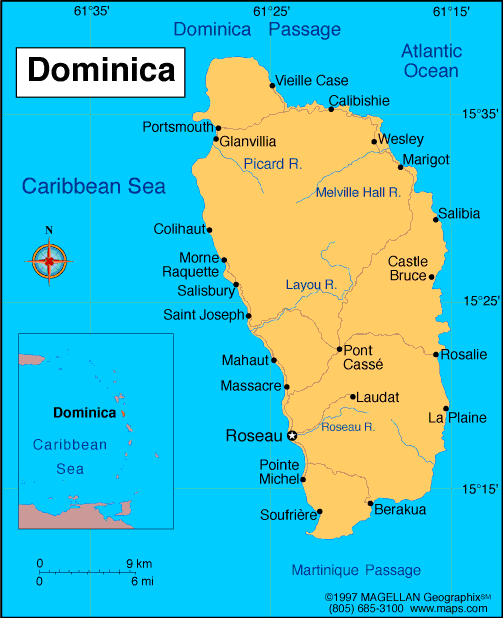Dominica is often known as “The Nature Island of the Caribbean” due to its spectacular, lush, and varied flora and fauna, which are protected by an extensive natural park system. The most mountainous island of the Lesser Antilles, its volcanic peaks are cones of lava craters and include Boiling Lake, the second-largest thermally active lake in the world.
Capital: Roseau
Currency: Eastern Caribbean Dollar (XCD)
Exchange rates for Eastern Caribbean dollars: January 2019: US$1 ≈ EC$2.7 (pegged), €1 ≈ EC$3.1.
Population: 72,000 (2003)
Country Code: +1767

Climate. Tropical; moderated by northeast trade winds; heavy rainfall. Flash floods are a constant threat; destructive hurricanes can be expected during the late summer months.
Terrain. Rugged mountains of volcanic origin. Highest point Morne Diablotin 1,447m
History. Dominica was the last of the Caribbean islands to be colonized by Europeans, due chiefly to the fierce resistance of the native Caribs. France ceded possession to Great Britain in 1763, which made the island a colony in 1805. In 1980, two years after independence, Dominica’s fortunes improved when a corrupt and tyrannical administration was replaced by that of Mary Eugenia Charles, the first female prime minister in the Caribbean, who remained in office for 15 years. Some 3,000 Carib Indians still living on Dominica are the only pre-Columbian population remaining in the eastern Caribbean.
GET IN
Visa. No visa, 6 months: Commonwealth, most eastern Europe, US. No visa, 3 months: most western countries, China.
By plane. Two airports: Melville Hall (Douglas–Charles Airport) (DOM) and Canefield (DCF). Most commercial flights land at Melville Hall but cannot accommodate jet aircraft. Access via San Juan, Antigua, Barbados, St. Maarten, Martinique, Guadeloupe and other Caribbean hubs.
By boat. Express des Isles runs services to Martinique and Guadeloupe.
GET AROUND
By car. The best way. Though small the island’s tightly turning mountain roads make for relatively long journeys and a hair-raising experience. Driving is on the left hand side, honk horn on hairpin turns, large trucks, pot holes and crumbling asphalt. A large 4×4 would be cumbersome on the small streets.
By bus or taxi. Bus on winding mountain roads is not the most comfortable. Taxi may not be expensive, particularly if shared. Hitch-hiking
Speak: English (official), French patois
Money. Eastern Caribbean dollars (XCD “$”) pegged to the US$1 ≈ EC$2.7
Shopping. Carib made baskets.
Music: jazz, reggae-dancehall, calypso & soca, to Cadence-lypso and Bouyon World Creole Music Festival in last week of October.
Eat Eat and drink local food and rum at this waterside local-style bar. Try fried plantains, codfish and bakes, fried fish and tamarind balls.
Drink. Freshly grapefruit, coconut water, sorrel (red refreshing drink brewed from the flowers of a hibiscus around Christmas. The popular locally brewed beer is Kubuli.
Quenchi is a local soft drink. Avocado pear juice, soursop, passionfruit, grapefruit, orange, lime, beetroot. Coffee is usually not very good, locals prefer tea and juice.
SAFETY. Dominica is one of the safest places to travel in the region. Although rare, petty crimes are most likely to happen around Roseau.
Health. Tap water is safe. Boils, fingernail and toenail fungi.
LGBT travellers should be aware that “buggery” (sodomy) is illegal
==============================================================NOMAD MANIA Dominica (Roseau)
World Heritage Sites: Morne Trois Pitons National Park
Tentative WHS
Fort Shirley (05/02/2015)
Morne Diablotin National Park (05/02/2015)
Soufriere-Scott’s Head Marine Reserve (05/02/2015)
Sights (Temporarily Reinstated). Touna Kalinago Heritage Village
Islands: Dominica
Borders: Dominica (sea border/port)
XL: St. John’s Parrish
Airports
Canefield (DCF)
Dominica (Douglas-Charles) (DOM)
Castles, Palaces, Forts: Fort Shirley
World of Nature
Cabrits NP
Morne Trois Pitons
Central Forest Reserve
Northern Forest Reserve
Festivals: Jazz ‘n Creole Festival
Experiences: Taste Mountain chicken
Botanical Gardens: Trafalgar: Papillote Tropical Gardens
Beaches
Batibou Beach
Wavine Cyrique Beach
Waterfalls
Salton Waterfalls
Trafalgar Falls (Sight)
Rivers
Layou River
Pagua River
Trails 1 – Treks: Waitukubuli National Trail
Open Air Museums: Kalinago Barana Autê (Carib Cultural Village by the Sea)
Cities of the Americas
ROSEAU World Capital
Museums: The Dominica Museum
Religious Temples: Cathedral of Our Lady of Fair Haven
Botanical Gardens: Dominica Botanic Gardens